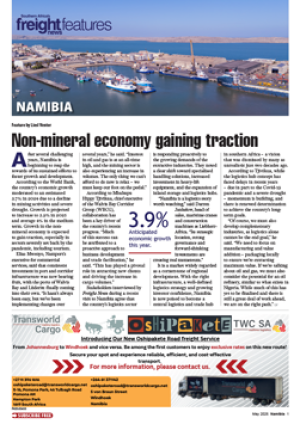PLANS FOR an industrial development zone (IDZ) to be served by a purpose-built bulk port at Coega 20 kilometres north of Port Elizabeth are progressing rapidly.
Coega IDZ Initiative director Doug Reed says a number of studies are being conducted to establish the commercial, environmental and technical viability of the proposed development, which will cover 10 000 hectares - the size of ten Karoo farms.
Provincial and national government are providing the funding for the studies, with Portnet alone having budgeted R3-m for its own feasibility and viability study.
Portnet does not want to duplicate the facilities at the existing Port Elizabeth harbour, according to port manager Jan Jansen. He says that, given the other development needs in the country, it would be irresponsible to duplicate facilities like container-handling.
The Coega port will be dedicated to the handling of bulk freight such as the manganese ore currently being exported through Port Elizabeth harbour and the import of feedstock for a planned R1,7-billion Gencor zinc refinery and a neighbouring R600-million fertiliser plant to be built by Kynoch.
Other investors interested in establishing plants in the proposed Coega IDZ are Pretoria Portland Cement, Murray and Roberts (a steel mill), Samancor (to process the manganese ore) and Willards batteries, says Port Elizabeth Regional Chamber of Commerce and Industry (Percci) ceo Kevin Wakeford.
Wakeford has been seconded by Percci to help with the marketing of the project to local and international investors. Gencor, whose own viability study for the building of a zinc refinery in the Eastern Cape is budgeted at R20-million, has given the Coega developers until the end of March to come up with a definite commitment to building a port at Coega.
If it does not get this commitment it will have to fall back on alternative sites in Port Elizabeth and East London. Wakeford says the Eastern Cape cannot afford to lose the Gencor investment, but he is keen to see it form the basis of an industrial development on the scale of Richards Bay. We want to provide investors with an export-oriented facility which will enable them to compete with anyone else anywhere in the world. Wakeford and Gencor argue that the Eastern Cape is well placed for international markets, being equidistant from the Americas, East and Europe. Wakeford adds it is also central to the main South African markets of Durban, Gauteng and Cape Town.
One of the prime movers behind the equalisation of rail tariffs between Gauteng and Port Elizabeth, he says the existing harbour is among the most efficient in Africa. By offloading containers here importers on the Reef are saving two days on a Durban loading because of our efficiencies.
Our port must be allowed to develop to serve light industry in the city. It cannot handle the bulk exports and imports needed by industry which will set up in the IDZ.
But it's not only the Port Elizabeth and the Eastern Cape that need this development. With our existing facilities at Richards Bay and Saldanha reaching capacity the whole of South Africa needs another industrial zone and purpose-built port. Ed Richardson
